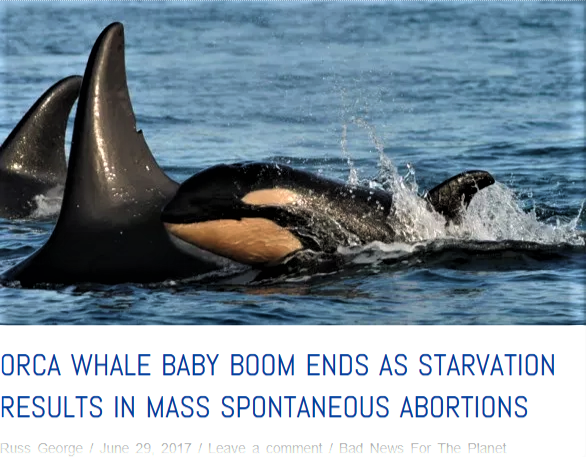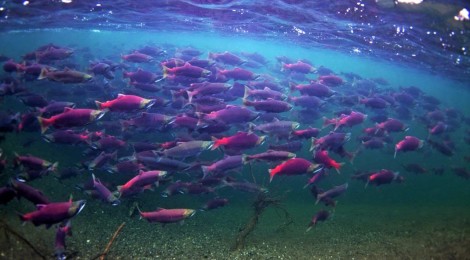
Salmon Miracle Continues Into Year 6
Good Maternal Nutrition Is Vital For Salmon
Healthy Mothers = Healthy and More Young’uns
Right now, in rivers and streams of Alaska and Canada that support Sockeye Salmon reports show a miracle of great numbers of the stunning scarlet salmon.
This year’s Sockeye are the offspring of the salmon that resulted from the miraculous restoration of their ocean salmon pasture.
How many miracles of the fishes are needed for the world to get with the program? It seems that this year, 2018, the sage advice about the wonder of it being better to give than to receive is proven again. The focus of my life for some decades has been to work on behalf of restoring natural ecosystems on this blue planet that needs help. I feel at times that mine is becoming a never-ending saga, but then some joys come to my attention. My joy is in seeing the waters full of fish.
In the news Wednesday, Aug. 15, 5:45 am PST the headline reads….
Bristol Bay Alaska wraps up ‘off the charts’ sockeye season. Commercial fishing in Alaska’s Bristol Bay this season has not only been fantastic, but record-breaking.
“It’s the largest sockeye salmon run on record, the second-largest harvest on record,” Andy Wink, executive director of Bristol Bay Regional Seafood Development reports on this year’s salmon miracle. Tragically in the rest of Alaska, the catch is pretty much equal to the worst ever. While the reason is complex it is perfectly explainable. Where the salmon enjoy rich ocean pastures instead of mostly starving they survive and thrive.
But ocean salmon pastures are mostly in a state of decline. This decline in ocean productivity is clearly seen in the fact that Alaska’s sockeye while numerous are shrinking in size, fish this year are 20% smaller than historic norms. The small size is causing trouble with the processing of the record catch as the fish are well below the size of the fish processing plants machinery and built for much larger fish.
Were it not for the trust and confidence of a tiny Indian village of 800 souls on a distant island in the Gulf of Alaska who came to me 10 years ago, a part of today’s miracle of the fishes would not be at hand. The people of that tiny village who had for millennia known themselves as ‘the people of the fish’ had asked me if we might together bring back the fish. We gave it a go.
Following the Sockeye Salmon story is a way to understand what keeps the oceans alive.
While the Alaskan’s in the Bering Sea are catching plenty of fish, farther to the south where the second-largest Sockeye Salmon watershed lies the story is the same as in Bristol Bay Alaska. But in between the fish are scarce.
At this very moment, some millions of Sockeye Salmon are swimming into the Fraser River that enters the Pacific at Vancouver Canada. The returning salmon are in such numbers that a great harvest of some few million of the fish is being permitted. This is in stark opposition to last year when the fish were so few that no harvest at all was allowed. Today as I write this post millions of Sockeye Salmon are swimming into the nets and onto the plates of people on Canada’s West Coast.
A forecast released yesterday noted that the famed Adams River spawning run of Sockeye is expected to be 7 million fish, last year only ten thousand fish returned to spawn. While Sockeye go through cycles, the cycles have rarely been as they are today. Now there are years where mere thousands of fish has become the rule, only sporadically changed by miraculous large numbers. Two years ago the return of salmon to the Fraser River was the smallest number in all of history.
A Fish Biology Primer
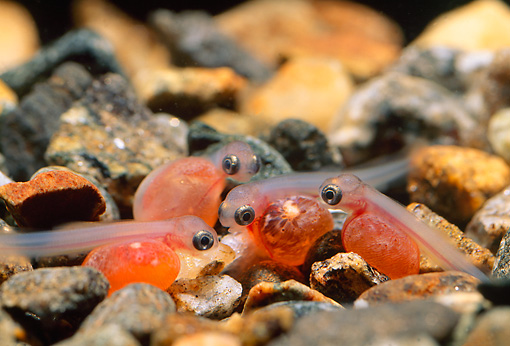
Salmon just hatched getting their first smell of home waters. Whether these baby salmon will return to spawn depends on them getting a healthy start in life.
In fish biology, the health of the eggs is a major factor (some would say THE major factor) in the survival rate and ongoing health of the hatchlings/smolts, and onto adulthood. The health of the eggs is almost entirely dependent on maternal nutrition, especially immediately before the mothers spawn when extra nutrition is packed into the eggs to give the hatchlings a better start in life.
This year’s Fraser sockeye salmon were born from grandmothers that fed on the restored ocean pasture that the village and I provided for them in the summer of 2012. They thrived on that pasture then laid their eggs in the rivers and streams that fall. The healthy baby salmon from those mothers swam out to sea two years later, 2014. They got a great head start in life both in numbers and healthy condition due to good maternal nutrition. Now right on schedule in their four-year life-cycle they have returned home to play their part in a renewed cycle of life.
Confirming the beneficial ripple effect of our restored ocean pasture on the Fraser sockeye is the large run of adults that arrived in perfect dusty time two years after the work of the Haida Salmon Restoration company. Now four years later, this modest miracle of fish, is not so much as a blessed miracle, rather a miracle of good intentions and hard work by 11 dusty shipmates who labored to feed the mother sockeye so that one day the people of the salmon would once again have salmon to feed their babies.
These are times of Feast and Famine for the fish
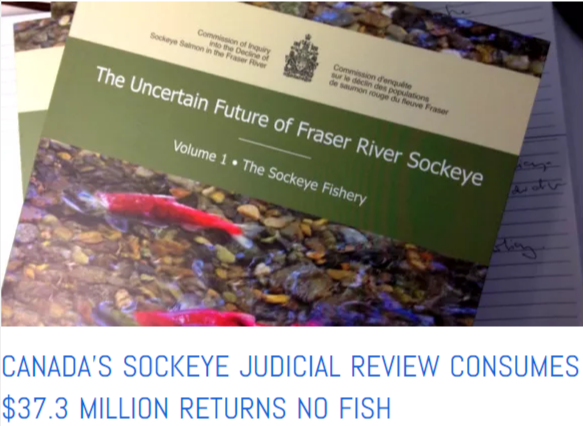
The $37 million in legal charges returned no additional fish. In stark contrast, our $2 million ocean pastures restoration project is on course to confirm an additional 500 million fish. Click to read more
In 2010 the forecast run of the iconic Sockeye salmon to the Fraser River was forecast to be the lowest number ever. The government of Canada commissioned supreme court justice Cohen to hold hearings where, under oath (and penalty of perjury), fish and ocean experts were summoned before the bench to testify why the fish were feared to be nearing extinction. What might be done? The commission would go on to spend $37 million dollars in its ‘investigation.’
Lawyers got rich, but for the fish, the victims, nothing. It was the same old tragic story of bureaucratic bafflegab.
A miracle of the fishes on the way to court
While Justice Cohen was holding court the fish were swimming home. They would not show up in Chief Justices court room to testify rather they would swim right by in a millions-strong march of the fish.
That year instead of the total returning fish arriving in the lowest number in all of history they, mysteriously to some, the fish arrived in the largest number in all of history. Depending on the expert one chooses the numbers were said to be a low of 32 million to a high of 40 million. Want to see the miracle in a short video, just click this link, 40 Million Salmon Can’t Be Wrong
What was it that fooled all the experts and brought the fish back?
As it happens Sockeye salmon have a life cycle of four years. They spend the first two years in fresh water on land and the last two years of their life far out to sea grazing on vast ocean pastures. Their ocean life is most important of all, they put on 98% of their adult body weight on their ocean pastures if those pastures are healthy. The health of the ocean fish pastures depends almost entirely on the arrival of vital dust that blows from land to sea. The fish pastures are so far from land that none of the minerals that wash out of rivers and streams makes it hundreds of miles offshore where the young salmon smolts go to grow.
So in 2010 while Justice Cohen was filling up his $37 million in legal ‘billable hours’ costs so he might pass judgment on what was right or wrong with the fish, the fish came back without any help from the supreme court. The miracle that brought the fish back was the eruption of the Alaskan Aleutian island volcano called Kasatochi.
In 2008 when the Kasatochi volcano in the Aleutian Islands of Alaska erupted in mid-August for a few days a plume of volcanic dust from the violent eruption drifted to the south and east dusting parts of the NE Pacific in the Gulf of Alaska. The volcanoes dust arrived very late in the ocean pasture growing season, rather like if you were to plant your vegetable garden in mid-August you might well not expect much of a harvest from the late gardening effort.
Even late in the summer, Kasatochi’s mineral-rich dust had a profound effect and the ocean pasture turned from clearest blue to murky green. A rich abundance of ocean plant life, phytoplankton, flourished and bloomed right in the best place, the nursery and rearing pastures of Pacific salmon.
It was by a coincidence especially well-timed for the last of the Pacific salmon that go to sea each year that the 2010 fish returned in great numbers to the Fraser River (the greatest sockeye salmon watershed of all). They are one of the stars of this story to be joined later by their cousins the Pink salmon, the Chum salmon, the Coho, and the Kings.
The sockeye arrived in their ocean pasture that year in the vast numbers of baby salmon as per the usual but following Kasatochi’s dusting they swam into an ocean pasture returned to historic abundance and carrying capacity. As every farmer and rancher knows the amount of livestock that a pasture can support and sustain depends entirely on the health and abundance of the pasture.
While Justice Cohen and his legal staff utterly ignored the salmon miracle of the volcano and its dust, fortunately not everyone did.
I’ve done a life’s work of ecorestoration for many years, going on five decades, but my best work was done in 2012 when with 11 native friends, my dirty dozen, we dusted 10,000 sq. kilometers of the Gulf of Alaska in our ‘salmon restoration’ effort. There is good news to come so do read on, some wonderful happened.
Being the Volcano, returning ocean pastures to historic health and abundance
In our distant patch of North Pacific, we weathered vicious 80+ mph winds, hurricane force, with waves blasting over the top of our 130 ft fishing/research ship. Noone escaped seasickness, some worse than others as our cook was so ill we had to evacuate her to hospital. But we weathered the storms and over the course of weeks hefted/man-handled 4000 50 lb bags of life-giving vital mineral dust to the deck from the holds of the ship. Our mission was to give back to the ocean something of ourselves to replenish and restore all of ocean life, from the bottom up.
Maternal Nutrition
If all went as planned over the 6 years in the making of the project which was fully supported by the Government of Canada the salmon ocean pasture would be restored in health. The first measure of success ought to be seen in Pink Salmon in 2013 and the next year, 2014, the Sockeye should come back to Canadian rivers and streams in great numbers. Even more, if the returning salmon were indeed benefiting from great maternal nutrition their offspring would continue to show up in greater numbers years later.

Looking astern off the transom of my research ship before we began our dusting to restore the ocean to health the ocean was a blue desert. After dusting the same view revealed a beautiful emerald-green see that had become full of life. (No Photoshop, raw camera)
Laboring to bring back the fish.
Where before we began our dusty work in intensive scientific surveys of that dying ocean pasture we rarely saw much of ocean life. A few birds each day was all. Once every few days perhaps one sighting of a whale.
Nothing was being caught by our ardent fishermen crew who were always, as on every research ship, seeking to catch fresh fish for dinner.

Our two Canadian government state-of-the-art Slocum Gliders provided by collaborating ocean science teams.
Our fleet of two Slocum glider ocean robots, the most sought after leading-edge ocean science instruments were on the job 24/7 diving and surfacing every two hours profiling the ocean from surface to the abyss with their array of instruments. Upon surfacing they dutifully dialed us up via their onboard satellite radios and reported on their progress and findings.
Along with those two Slocum gliders were a collection of 20 Argus drifter robots contributed to the project by NASA. These satellite-linked instruments we would deploy throughout the many weeks at sea, some continued to send back data for more than a year. Click this link to read more of how to recreate the garden of Eden.
THE RESULTS, IT JUST WORKS, AND WORKS, AND WORKS
The very next year the first of many salmon miracles recreated by a dirty dozen made up of myself and 11 shipmates were revealed. Just about this time in the late summer/fall of 2013 everywhere from Alaska to the lower 48, baby salmon that had swum out to sea, instead of mostly starving were instead treated to our feast on newly vibrant ocean pastures where once they could neither thrive nor survive. They grew and grew and before too long they swam back to our rivers a five hundred million strong.
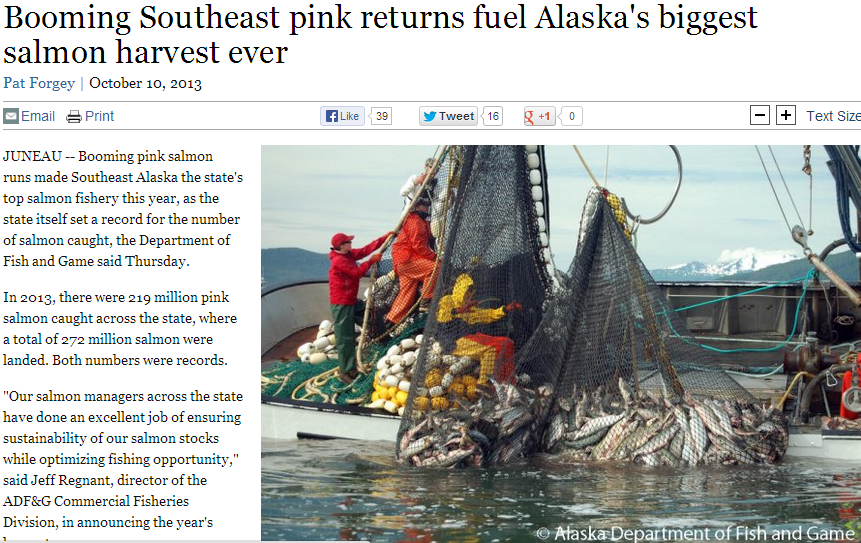
My 2012 ocean pasture replenishment and restoration work in the NE Pacific returned the ocean to life as seen in the largest catch of salmon in all of history in Alaska the next year. CLICK TO READ MORE
NOT JUST 2013
While our ocean pasture restoration returned in 2013 the largest number of Pink salmon in history right on schedule for their 2-year life cycle. What might have happened the next year, 2014, keeping time with the life cycle of Sockeye salmon 🙂
Record-breaking year predicted for Fraser River sockeye run
Salmon fishing seasons set and should lead to a blissful summer …
Anticipated salmon run could overwhelm Fraser River this …
Click this link for a rockin video all about How 40 Million Fraser River Sockeye Can’t Be Wrong!
Whew…. I am running out of steam at this moment on telling this new miracle of the fishes parable. Check back tomorrow for more.
The Orca whale baby boom of 2015 that followed in perfect gestational timing with the restoration our Gulf of Alaska ocean salmon pasture produced the largest number of healthy baby whales ever recorded. Those well nourished mother Orca’s produced healthy babies. Tragically the baby boom only lasted a short time. Ocean science reports now show mother Orca’s are unable to carry their babies to term due to starvation brought on by the collapse of their food supply, salmon.
This roller coaster ecological ride reveals that the stability of the ocean pastures is under grave threat by humanities deadly toll of both active damage and cries to do nothing. We can bring back the fish. Join me.











